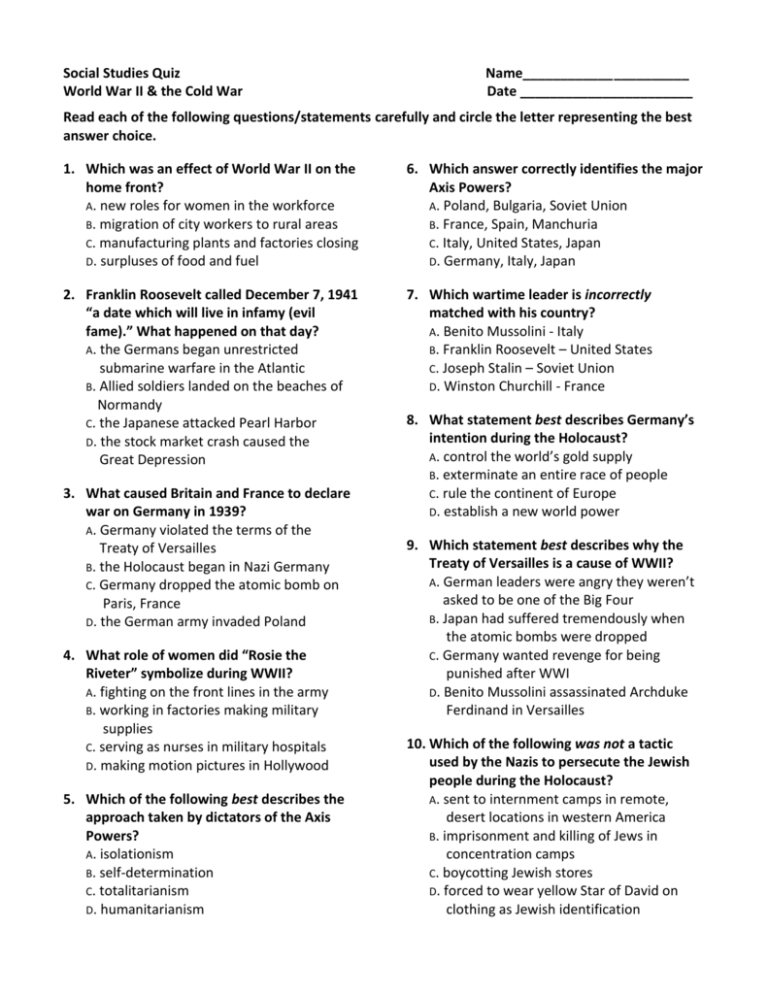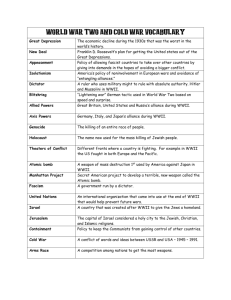WWII & Cold War Social Studies Quiz
advertisement

Social Studies Quiz World War II & the Cold War Name______________________ Date _______________________ Read each of the following questions/statements carefully and circle the letter representing the best answer choice. 1. Which was an effect of World War II on the home front? A. new roles for women in the workforce B. migration of city workers to rural areas C. manufacturing plants and factories closing D. surpluses of food and fuel 6. Which answer correctly identifies the major Axis Powers? A. Poland, Bulgaria, Soviet Union B. France, Spain, Manchuria C. Italy, United States, Japan D. Germany, Italy, Japan 2. Franklin Roosevelt called December 7, 1941 “a date which will live in infamy (evil fame).” What happened on that day? A. the Germans began unrestricted submarine warfare in the Atlantic B. Allied soldiers landed on the beaches of Normandy C. the Japanese attacked Pearl Harbor D. the stock market crash caused the Great Depression 7. Which wartime leader is incorrectly matched with his country? A. Benito Mussolini - Italy B. Franklin Roosevelt – United States C. Joseph Stalin – Soviet Union D. Winston Churchill - France 3. What caused Britain and France to declare war on Germany in 1939? A. Germany violated the terms of the Treaty of Versailles B. the Holocaust began in Nazi Germany C. Germany dropped the atomic bomb on Paris, France D. the German army invaded Poland 4. What role of women did “Rosie the Riveter” symbolize during WWII? A. fighting on the front lines in the army B. working in factories making military supplies C. serving as nurses in military hospitals D. making motion pictures in Hollywood 5. Which of the following best describes the approach taken by dictators of the Axis Powers? A. isolationism B. self-determination C. totalitarianism D. humanitarianism 8. What statement best describes Germany’s intention during the Holocaust? A. control the world’s gold supply B. exterminate an entire race of people C. rule the continent of Europe D. establish a new world power 9. Which statement best describes why the Treaty of Versailles is a cause of WWII? A. German leaders were angry they weren’t asked to be one of the Big Four B. Japan had suffered tremendously when the atomic bombs were dropped C. Germany wanted revenge for being punished after WWI D. Benito Mussolini assassinated Archduke Ferdinand in Versailles 10. Which of the following was not a tactic used by the Nazis to persecute the Jewish people during the Holocaust? A. sent to internment camps in remote, desert locations in western America B. imprisonment and killing of Jews in concentration camps C. boycotting Jewish stores D. forced to wear yellow Star of David on clothing as Jewish identification 11. Which of the following was part of the United States strategy to win the War in the Pacific? A. trench warfare B. tank attacks in north Africa C. island hopping D. attacking supply lines in Manchuria 16. Which United States president made the decision to drop atomic bombs on Hiroshima and Nagasaki? A. Harry S. Truman B. Franklin D. Roosevelt C. Dwight D. Eisenhower D. Douglas MacArthur 12. Which of the following does not accurately identify a major Axis Power and its leader? A. Soviet Union, Joseph Stalin B. Japan, Hideki Tojo C. Germany, Adolf Hitler D. Italy, Benito Mussolini 17. Why is this deadliest war also called the “good war?” A. the use of air raids caused much less bloodshed than in WWI B. many ordinary citizens became involved at home to help the war effort C. nations banded together to defeat aggressive dictators in Europe and Asia D. anti-Semitism celebrated the accomplishments of Japanese Americans during the war 13. Which of the following correctly sequences major WWII events? A. Soviet Union defeats Germany at Stalingrad, Germany invades Poland, Japan surrenders, U.S. enters the war B. Germany invades Poland, Japan attacks Pearl Harbor, U.S. enters the war, D-Day Invasion, Atomic bombs dropped on Japan C. Japan attacks Pearl Harbor, Great Britain and France declare war on Germany, D-Day Invasion 14. What were the fates of Benito Mussolini and Adolf Hitler? A. Both surrendered in late 1945. They were imprisoned, tried, and put to death. B. Mussolini was hanged by his countrymen; Hitler committed suicide in his bunker. C. Both escaped capture and, it is believed, fled to Argentina. D. Both surrendered, were tried, and were imprisoned for life. 15. Which was a major Allied victory over Japan in the Pacific? A. Battle of the Atlantic B. Stalingrad C. Battle of Midway D. D-Day 18. Which group of American citizens was sent to internment camps (wartime jails) for fear they were spies during WWII? A. Polish Americans B. Native Americans C. African Americans D. Japanese Americans 19. All of the following were major battlefronts in WWII except? A. China B. North Africa C. Pacific D. Europe 20. Fascist Italy, Nazi Germany, and military rule in Japan are all examples of what? A. total control by dictators which deny individual freedoms B. very powerful economic systems ruled by supply and demand C. democracy in action D. system of checks and balances so no one person has complete power 21. Which event in 1941 caused the United States to enter World War II? A. Germany’s invasion of Poland B. Japan’s attack on Hawaii C. Hitler’s killing of Jewish people D. the sinking of American ships by German U-boats 22. The president defended his decision to drop the atomic bomb by arguing that it would A. prolong (lengthen) the war. B. avoid huge U.S. troop casualties. C. punish the Japanese. D. reduce civilian deaths. 23. Which famous battle fought on Russian soil halted the German advance in WWII? A. Alamein B. Gallipoli C. Normandy D. Stalingrad 24. After World War II, the Marshall Plan provided A. economic aid to European countries recovering from the war. B pardons to all former spies. C. reparations to formerly interned Japanese. D. United States military protection for Japan’s emperor. 25. The two superpowers that emerged after World War II were A. Japan and Germany. B. the United States and Great Britain. C. the Soviet Union and India. E. the United States and Soviet Union. 26. Which economic system rewards individual achievement and competition? A. Socialism B. Capitalism C. Communism D. Fascism 27. What is the primary goal of the United Nations? A. to stop communism B. to stop the Far East from building weapons C. to prevent future wars D. to replace all nation’s governments with a single world government 28. The Cuban Missile Crisis began when A. the Soviet navy ran the United States blockade of Cuba. B. a United States spy plane was shot down over Cuba. C. the Soviets began to build missile launching sites in Cuba. D. the Cubans began an invasion of the United States missile site. 29. The Cuban Missile Crisis ended when A. the Soviets agreed to remove missiles from Cuba. B. the United States bombed Soviet missile sites. C. the United States negotiated with Castro to destroy missile sites. D. the United Nations forced the two sides to compromise on missiles. 30. The purpose of the North Atlantic Treaty Organization was to A. help Europe rebuild after the damage of WWII. B. find peaceful uses for nuclear energy. C. promote democracy in European countries. D. protect member countries from Soviet aggression. 31. The United States policy to hold communism within the Soviet Union and Eastern Europe is known as A. the Domino Theory. B. the Open Door Policy. C. mutual assured destruction. D. containment. 32. Which event in 1950 made the Cold War “hot?” A. Vietnam War B. Korean War C. Cuban Missile Crisis D. World War II 33. The Viet Cong were A. South Vietnamese who were sympathetic to the communist cause. B. North Vietnamese who were sympathetic to the communist cause. C. United States soldiers fighting for the communists. D. South Vietnamese who were fighting with the Americans. 34. The Warsaw Pact was A. a branch of NATO. B. a branch of the United Nations. C. the Soviet answer to NATO. D. a treaty signed between Russia and Poland. 35. What was not true about the Cold War? A. it divided the world into two camps B. it resulted in an armed conflict between the U.S. and the Soviet Union C. It was based on differences in ideologies—the U.S, democratic and capitalist; the Soviet Union, dictatorial and communist. D. It was characterized by a state of tension between the U.S. and Soviet Union 36. One reason for United States involvement in Vietnam was to A. force the Soviet Union to remove missiles from Vietnam. B. get Vietnamese raw materials for use in American industry. C. keep communists from taking control of the Vietnamese government. D. bring in fuel and supplies after the Soviet Union cut the country off from the outside world. 37. The fall of the Berlin Wall signaled the collapse of A. fascism in Eastern Europe. B. socialism in Western Europe. C. monarchy in Western Europe. D. communism in Eastern Europe. 38. Who was president during the Cuban Missile Crisis? A. Harry S. Truman B. Ronald Reagan C. Lyndon B. Johnson D. John F. Kennedy Use the map on the next page to answer questions # 39 - 43. 39. Which numbers label two major Axis Powers? A. 3 and 5 B. 1 and 5 C. 3 and 7 D. 7 and 4 40. Which numbers label two major Allied Powers? A. 3 and 5 B. 1 and 5 C. 3 and 7 D. 7 and 4 41. Which number labels the country Germany invaded starting World War II? A. 2 B. 3 C. 4 D. 9 42. Which number labels the country where the D-day invasion took place? A. 2 B. 1 C. 6 D. 5 43. Which number labels the country of Benito Mussolini? A. 3 B. 4 C. 10 D. 7 It’s time for a bit of “old stuff.” 44. What was granted in 1920 by passing the 19th amendment to the Constitution? A. Women’s suffrage B. Abolition of slavery C. Prohibition repealed D. Right to bear arms 45. The fifty states can be grouped into regions based on specific characteristics. In which geographic region is Virginia located? A. Northeast B. Midwest C. Southwest D. Southeast 46. Which labor union was founded by Samuel Gompers in 1886 during the Gilded Age? A. United Auto Workers (UAW) B. American Federation of Labor (AFL) C. Knights of Labor D. Congress of Industrial Organizations (CIO) 47. Which of the following groups gained power by helping the poor in exchange for votes? A. Monopolies B. Political machines C. Reformers D. Political activist 48. Armed resistance of Native Americans to white settlement of their lands in the West ended __________________________. A. when Geronimo was captured by the U.S. army B. with the Massacre at Wounded Knee C. at the Battle of Little Bighorn D. when the Nez Perce fled to Canada 49. New railroads helped to stimulate economic growth the most A. after the Civil War B. during World War I C. before the Civil War D. during the Great Depression 50. Which of the following was one reason for the failure of Prohibition? A. Unpopularity of the restriction B. Passage of the Twenty-first C. The start of World War I D. An increase in public drunkenness 51. Negative effects of industrialization included ________________. A. formation of unions B. reduced work hours C. restrictions on child labor D. unsafe working conditions 52. Which U.S. president expanded the Monroe Doctrine to include the right to use force in Latin America? A. William McKinley B. Woodrow Wilson C. Franklin Roosevelt D. Theodore Roosevelt You are finally finished! Take a break, then go back and check your work carefully!







